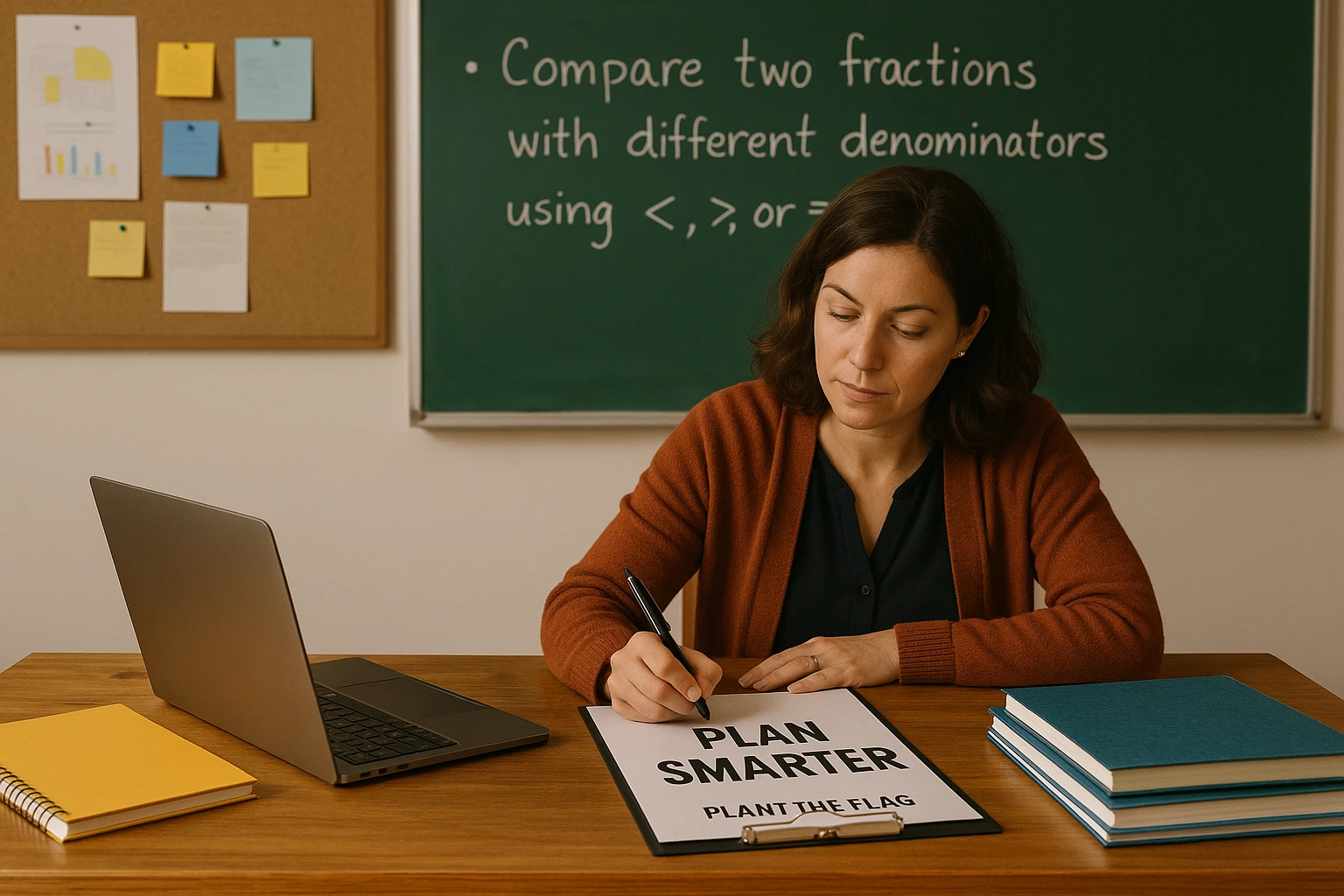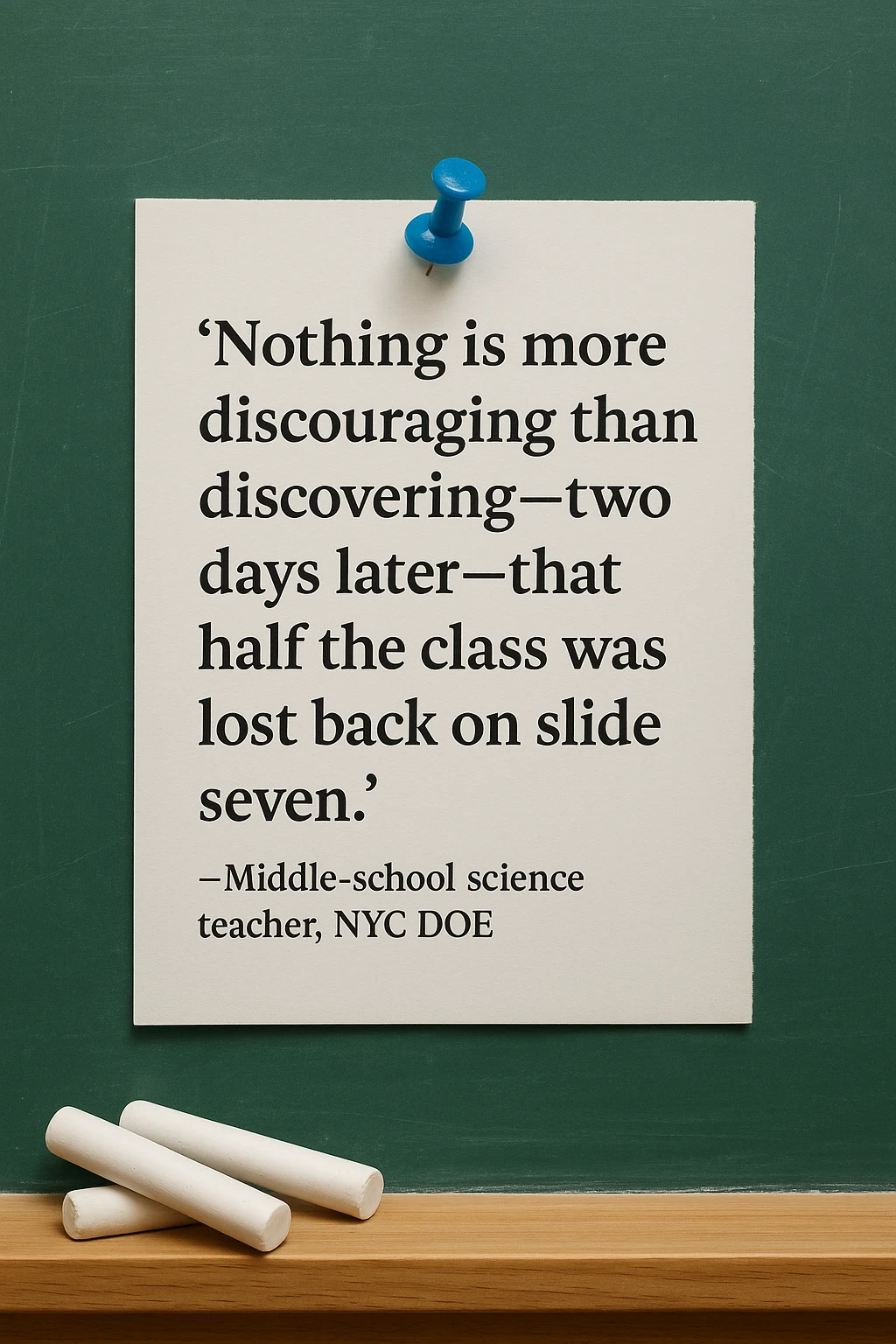LessonPlansReality-Proof Lesson Planning A Teacher-Centered Blueprint that actually works
Seven practical moves—rooted in Understanding by Design and battle-tested in real classrooms—to cut planning time, raise engagement, and survive the week with your sanity intact.

"The curriculum keeps growing but my prep periods don't." —Every teacher, everywhere
Planning shouldn't feel like an unpaid second job. Below is the streamlined planning system we refined while building GuidingNest—borrow it, tweak it, make it your own.
1. Plant the Flag – Start backwards
UbD rule #1: design from the finish line. Before you open Google Slides or scavenge for worksheets, write one clear performance goal on a sticky note:
By Friday students will _____
Real-life flags
| Grade/Subject | End-of-Week Mastery Statement |
|---|---|
| 3-Math | "Compare fractions with unlike denominators using >, <, = on a number-line." |
| 8-ELA | "Draft a claim-evidence-reasoning paragraph that uses two valid sources." |
| HS-Bio | "Model cellular respiration with a labeled diagram and 60-second peer explanation." |
Why it matters: When the flag is visible, every slide, station, and exit ticket either marches toward it—or gets deleted. Less clutter, more learning.
2. Write the Proof
Assessment first, not last
If you can't see the target, your students can't hit it.
Quick-build ideas
| Proof Type | Works Best For | Example |
|---|---|---|
| Micro-performance (3-5 min) | Skills you can watch | Students pair-explain numerator vs. denominator while teacher circulates with a rubric-on-a-card. |
| Artifact snapshot | Concepts that leave evidence | Upload a photo of a science model to a class Padlet; peers tag one strength, one fix. |
| "One-take" video | Communication standards | 60-second persuasive pitch recorded on Chromebook—graded on clarity + technique. |
Designing the proof now lets you backwards-map the minimum teaching moves required—no more "I guess we also need..." expansions that eat your prep.
3. Choose Methods That Match the Brain
Class sizes keep rising; attention spans are not. Mix modalities so every student bumps into the content at least three ways.
| Objective | Your Frustration | High-yield Method |
|---|---|---|
| Identify fraction parts | "They forget five minutes later." | 🔄 See-Think-Sketch: Students draw three food pics (pizza, candy bar, orange) and label parts; gallery walk = spaced retrieval. |
| Compare unlike fractions | "Common denominators melt their brains." | 🧩 Manipulative Hack: Cut cheap paint-chip strips into sixths, eighths, tenths; kids physically overlay to see size. |
| Draft strong thesis | "They write topic sentences, not claims." | ✂️ Color-Code Surgery: Provide printed essays; in pairs, highlight claim, evidence, reasoning in three colors, then swap. |
Pro-tip: Keep a reusable Method Library in your drive: twenty strategies you like, tagged by cognitive demand. Planning becomes plug-and-play.
4. Chunk & Sequence
The 10-Minute Rhythm
Research (Rosenshine, 2012) shows attention dips after 10-12 minutes. Structure your block as micro-chunks:
- Hook (≤5 min) – curiosity spark or prior-knowledge jog.
- Mini-Input (10 min) – direct modelling, think-alouds.
- Active Grapple (10 min) – guided or collaborative practice.
- Quick Temperature Check (2-3 min) – show-of-fingers, sticky dots, or a 3-question GuidingNest pulse-check.
- Deep-Dive (15 min) – independent or station rotation.
- Reflection (5 min) – "Today I advanced because..." journal or exit slip.
Repeat or extend segments based on live data. Pacing is flexible; the rhythm keeps you and students out of the fog.
5. Plan for Cognitive Load, not Clock Time
45 minutes ≠ 45 units of content.
- Rule of two: If a concept has two new pieces of vocabulary, trim supplemental facts.
- Brain breaks: 60-second movement or retrieval every 15-20 min improves memory more than powering through.
- Elastic buffer: Schedule 5 spare minutes in every lesson. Use it for stretch-questions… or breathing when tech glitches.
6. Gather (and Sanity-Proof) Materials
Nothing torpedoes momentum like "Hold on while I find the video."
Create a single-slide LaunchPad with all links, PDFs, timers, and rubrics hyper-linked. Test on the exact projector you'll use—font sizes that work on a laptop often vanish on a SmartBoard.
Analog fallback: Keep 10 printed copies of critical resources. When Wi-Fi ghosts you, learning continues.
7. Reflect, Iterate, Repeat
After the bell:
- 30-Second Gut Check – Did students hit the flag? Why/why not?
- Capture evidence – Snap photos of student work, note misconceptions.
- Tweak tomorrow – One change only; resist burning down the whole plan nightly.
Small, continuous refinements beat Sunday-night overhauls.
🧭 Quick-Grab Planning Template (copy–paste into your notebook)
### Flag
By ____, students will ____
### Proof
[Assessment description + 3-point rubric]
### Methods & Flow
1. Hook –
2. Input –
3. Active Grapple –
4. Check –
5. Deep-Dive –
6. Reflection –
### Materials
Links / copies / manipulatives / backup plan
### Post-Lesson Notes
Wins:
Gaps:
Tomorrow tweak:
Example:
Here’s a filled-out sample for a 3-Math lesson on comparing fractions with unlike denominators:
Flag
By Friday, students will compare fractions with unlike denominators using >, <, or = on a number-line.
Proof
Exit Ticket: On mini-whiteboards, students place two given fractions on a blank number-line and write the correct symbol between them.
3-Point Rubric:
- 3 pts – Both fractions correctly placed and correct symbol with brief reasoning.
- 2 pts – Correct symbol but one placement error.
- 1 pt – Incorrect symbol or more than one placement error.
Methods & Flow
- Hook (≤5 min) • Show two “pizza slices” images (¾ vs. 2⁄3) and ask “Which is bigger?” in a quick poll.
- Input (10 min) • Model on document camera: draw a number-line, mark 0, 1, then show how to partition into thirds vs. fourths.
- Active Grapple (10 min) • Students work in pairs with fraction-strip manipulatives to build their own number-lines and compare ⅝ vs. 3⁄5.
- Quick Check (2–3 min) • Thumbs-up if you can explain why one fraction is larger; thumbs-down if not.
- Deep-Dive (15 min)
Rotate through 3 stations (5 min each):
- Digital: Interactive number-line app with auto-feedback.
- Hands-On: Paint-chip strips to overlay and compare sizes.
- Partner Quiz: Student A says two fractions; Student B records placement & symbol.
- Reflection (5 min) In journals complete: “Today I advanced because ____” and “Next I need to ____.”
Materials
- Links: Google Slides with number-line templates; fraction-strip app link
- Copies: Printed fraction-strips; blank number-line exit tickets
- Manipulatives: Paint-chip strips cut into sixths and eighths
- Backup: Worksheet of 10 static fraction pairs
Post-Lesson Notes
- Wins: 85% placed and symboled correctly in Active Grapple.
- Gaps: 3 students still reverse numerator/denominator when partitioning.
- Tomorrow Tweak: Add a 2-min mini-input on interpreting “parts of a whole” before students begin.
Feel free to swap in your own fractions, tools, or timing—this shows exactly how the template turns into a real plan.
Why Teachers Say This Works
Time: cuts average prep from 90 → 45 min.
Clarity: students know the goal; behavior issues drop.
Sanity: you leave Friday with energy for real life.
Final Thought
Curriculum mandates, testing pressures, and ever-shrinking planning periods aren't going away. But a backward-designed, brain-friendly routine gives you leverage over the chaos. Steal these steps, adapt them, and keep fighting the good fight.
GuidingNest exists to automate the grunt work—but great teaching will always be human.
Stay sharp,
—The GuidingNest Team
